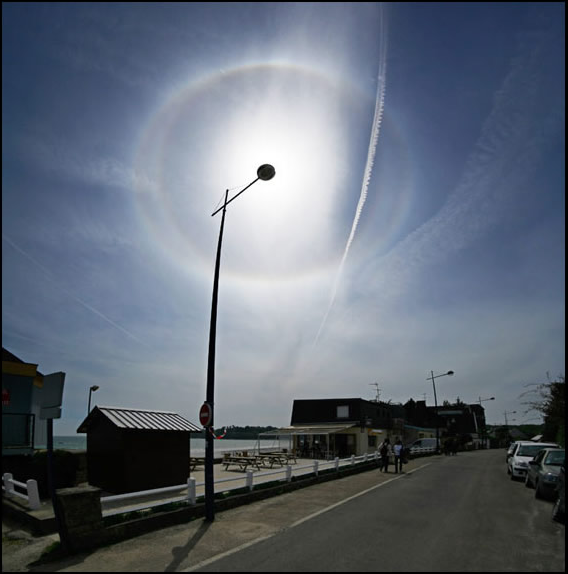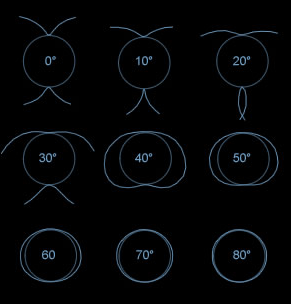High sun halos
Exploring the Phenomenon of High Sun Halos
High sun halos are a captivating atmospheric optics phenomenon that occurs when the sun is at a relatively high position in the sky. While most people are familiar with the 22 degree halo, high sun halos offer a unique and often misunderstood spectacle. In this article, we will delve into the details of high sun halos, shedding light on their formation, appearance, and the fascinating science behind them.
Understanding the Basics: The Circumscribed Halo and the 22 Degree Halo
The core of a high sun halo is the well-known 22 degree halo, which appears as a circular ring around the sun. However, what sets high sun halos apart is the presence of an additional halo that surrounds and touches the 22 degree halo at its top and bottom. This outer halo is known as the circumscribed halo.
The Evolution of High Sun Halos
At lower sun angles, two tangent arcs can be observed alongside the 22 degree halo. As the sun climbs higher in the sky, these arcs gradually merge to form the circumscribed halo. Initially, the shape of the circumscribed halo may appear drooping and oval-shaped. However, as the sun continues to rise, the oval tightens until it becomes almost perfectly circular. This circular appearance often leads to confusion, as it closely resembles the less vibrant 22 degree halo.
Factors Influencing High Sun Halo Visibility
Several factors contribute to the visibility and intensity of high sun halos. These include:
-
Atmospheric Conditions: High sun halos are more likely to occur in atmospheric conditions where ice crystals are present in the upper atmosphere. These ice crystals act as prisms, refracting sunlight and creating the halo phenomena.
-
Sun Angle: As the name suggests, high sun halos are only visible when the sun is at a relatively high position in the sky. Therefore, they are more commonly observed during midday or early afternoon.
-
Crystal Shape and Orientation: The shape and orientation of the ice crystals play a crucial role in the appearance of high sun halos. Hexagonal plate-shaped ice crystals are often responsible for the formation of the circumscribed halo, while column-shaped crystals contribute to the 22 degree halo.
Distinguishing High Sun Halos from Other Optical Phenomena
High sun halos can sometimes be mistaken for other atmospheric optical phenomena due to their circular shape and similar appearance to the 22 degree halo. However, there are a few key characteristics that can help differentiate high sun halos from other phenomena:
-
Location: High sun halos are typically located around the sun, whereas other phenomena like sundogs or circumzenithal arcs occur at different positions in the sky.
-
Coloration: The colors observed in high sun halos tend to be less vibrant compared to phenomena like sundogs. The circumscribed halo often exhibits a white or pale coloration, while the 22 degree halo may display a faint rainbow of colors.
-
Halo Size: The size of high sun halos can vary depending on atmospheric conditions and the altitude of the observer. However, they are generally smaller in diameter compared to other optical phenomena.
Capturing the Beauty of High Sun Halos
Photographing high sun halos can be a rewarding experience for both amateur and professional photographers. To capture the intricate details and subtle colorations of these phenomena, consider the following tips:
-
Use a Polarizing Filter: A polarizing filter can help reduce glare and enhance the visibility of the halo.
-
Adjust Exposure Settings: Experiment with exposure settings to ensure that both the halo and the surrounding sky are properly exposed.
-
Include Interesting Elements: Incorporating natural or man-made objects in your composition can add depth and context to your high sun halo photographs.
Conclusion
High sun halos offer a mesmerizing display of light and color, adding a touch of magic to our skies. Understanding the formation and characteristics of these phenomena allows us to appreciate their beauty and distinguish them from other optical effects. So, the next time you find yourself gazing at the sky on a sunny day, keep an eye out for the subtle yet captivating presence of high sun halos.

High Sun Halos imaged by Laurent Laveder (site, Sky Photos ) in France. ©Laurent Laveder, shown with permission.
The inner circular halo is the familiar 22 degree halo.
Surrounding it and touching at top and bottom is a circumscribed halo. At low sun there are two tangent arcs. As the sun climbs they join to form the circumscribed halo, initially a drooping oval shape. At higher sun the oval tightens and eventually it is almost circular. When nearly circular It is often mistaken for the less colourful 22 degree halo.

Note: this article has been automatically converted from the old site and may not appear as intended. You can find the original article here.
Reference Atmospheric Optics
If you use any of the definitions, information, or data presented on Atmospheric Optics, please copy the link or reference below to properly credit us as the reference source. Thank you!
-
<a href="https://atoptics.co.uk/blog/high-sun-halos/">High sun halos</a>
-
"High sun halos". Atmospheric Optics. Accessed on April 25, 2024. https://atoptics.co.uk/blog/high-sun-halos/.
-
"High sun halos". Atmospheric Optics, https://atoptics.co.uk/blog/high-sun-halos/. Accessed 25 April, 2024
-
High sun halos. Atmospheric Optics. Retrieved from https://atoptics.co.uk/blog/high-sun-halos/.